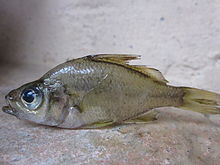Glass perch
| Glass perch | ||||||||||||
|---|---|---|---|---|---|---|---|---|---|---|---|---|

Different types of glass perch in an illustration from "The fishes of India; being a natural history of the fishes known to inhabit the seas and fresh waters of India, Burma, and Ceylon." by the British ichthyologist Francis Day (1829–1889). |
||||||||||||
| Systematics | ||||||||||||
|
||||||||||||
| Scientific name | ||||||||||||
| Ambassidae | ||||||||||||
| Klunzinger , 1870 | ||||||||||||
The family of glass perches (Ambassidae, Syn. Chandidae) belongs to the group of perch relatives (Percomorphaceae) and comprises 8 genera with over 50 species .
features
Glass bass are small fish, only two to 26 centimeters long. They have a high-backed, laterally compressed body. Many species are partially transparent so that bones and internal organs are visible. Glassfish have a high, first dorsal fin with seven or eight hard fin rays . The second, soft-rayed dorsal fin has seven to eleven rays, the anal fin has three hard and seven to eleven soft rays.
distribution
The fish live in the coastal sea, in brackish water and in fresh water in the region of the Indian Ocean and the western, tropical Pacific from Madagascar via India to Australia .
Way of life
Glassfish eat small crustaceans . For reproduction, they attach their eggs to aquatic plants or lay pelagic eggs.
Systematics

- Genus Ambassis
- Ambassis agassizii Steindachner , 1867 .
- Ambassis agrammus Günther , 1867 .
- Ambassis ambassis ( Lacépède , 1802) .
- Ambassis buruensis Bleeker , 1856 .
- Ambassis buton Popta, 1918 .
- Ambassis dussumieri Cuvier , 1828 .
- Ambassis elongatus ( Castelnau , 1878) .
- Ambassis fontoynonti Pellegrin, 1932 .
- Ambassis gymnocephalus (Lacépède, 1802) .
- Ambassis interrupta Bleeker, 1852 .
- Ambassis jacksoniensis (Macleay, 1881) .
- Ambassis kopsii Bleeker, 1858 .
- Ambassis macleayi (Castelnau, 1878) .
- Ambassis macracanthus Bleeker, 1849 .
- Ambassis marianus Günther, 1880 .
- Ambassis miops Günther, 1872 .
- Ambassis muelleri Klunzinger, 1880 .
- Ambassis nalua (Hamilton, 1822) .
- Ambassis natalensis Gilchrist & Thompson, 1908 .
- Ambassis urotaenia Bleeker, 1852 .
- Ambassis vachellii Richardson , 1846 .
- Genus Chanda
- Chanda nama Hamilton, 1822 .
- Genus Denariusa
- Denariusa australis (Steindachner, 1867) .
- Genus Gymnochanda
- Gymnochanda filamentosa Boeseman, 1957 .
- Gymnochanda flamea Roberts, 1994 .
- Gymnochanda limi Kottelat, 1995 .
- Gymnochanda ploegi Tan & Lim, 2014 .
- Gymnochanda verae Tan & Lim, 2011 .
- Genus Paradoxodacna
- Paradoxodacna piratica Roberts, 1989 .
- Genus Parambassis
- Parambassis alleni Datta & Chaudhuri, 1993 .
- Parambassis altipinnis Allen, 1982 .
- Parambassis apogonoides (Bleeker, 1851) .
- Parambassis baculis (Hamilton, 1822) .
- Parambassis bistigmata Geetakumari, 2012 .
- Parambassis confinis (Weber, 1913) .
- Parambassis dayi (Bleeker, 1874) .
- Parambassis gulliveri (Castelnau, 1878) .
- Parambassis lala (Hamilton, 1822) .
- Parambassis macrolepis (Bleeker, 1857) .
- Parambassis pulcinella Kottelat, 2003 .
- Parambassis ranga (Hamilton, 1822) .
- Parambassis serrata Dishma & Vishwanath, 2015 .
- Parambassis siamensis (Fowler, 1937) .
- Parambassis tenasserimensis Roberts, 1994 .
- Parambassis thomassi (Day, 1870) .
- Parambassis Vollmeri Roberts, 1994 .
- Parambassis waikhomi Geetakumari & Basudha, 2012 .
- Parambassis wolffii (Bleeker, 1851) .
- Genus Pseudambassis
- Pseudambassis roberti Datta & Chaudhuri, 1993 .
- Genus Tetracentrum
- Tetracentrum apogonoides (Bleeker, 1851) .
- Tetracentrum caudovittatus (Norman, 1935) .
- Tetracentrum honessi (Schultz, 1945) .
Aquarium keeping
Some species are kept in aquariums . They are considered to be sensitive pets who only accept live food and are very scared. Some species were also bred. The tiny size of the larvae makes rearing very difficult.
literature
- Joseph S. Nelson : Fishes of the World , John Wiley & Sons, 2006, ISBN 0-471-25031-7
- Hans A. Baensch & Rüdiger Riehl : Aquariums Atlas, Volume 1 to 4 . Mergus Publishing House
- Tyson R. Roberts, 1994. Systematic revision of tropical Asian freshwater glass perches (Ambassidae), with descriptions of three new species. Nat. Hist. Bull. Siam Soc. 42: 263-290.
Web links
- Glassfish on Fishbase.org (English)




